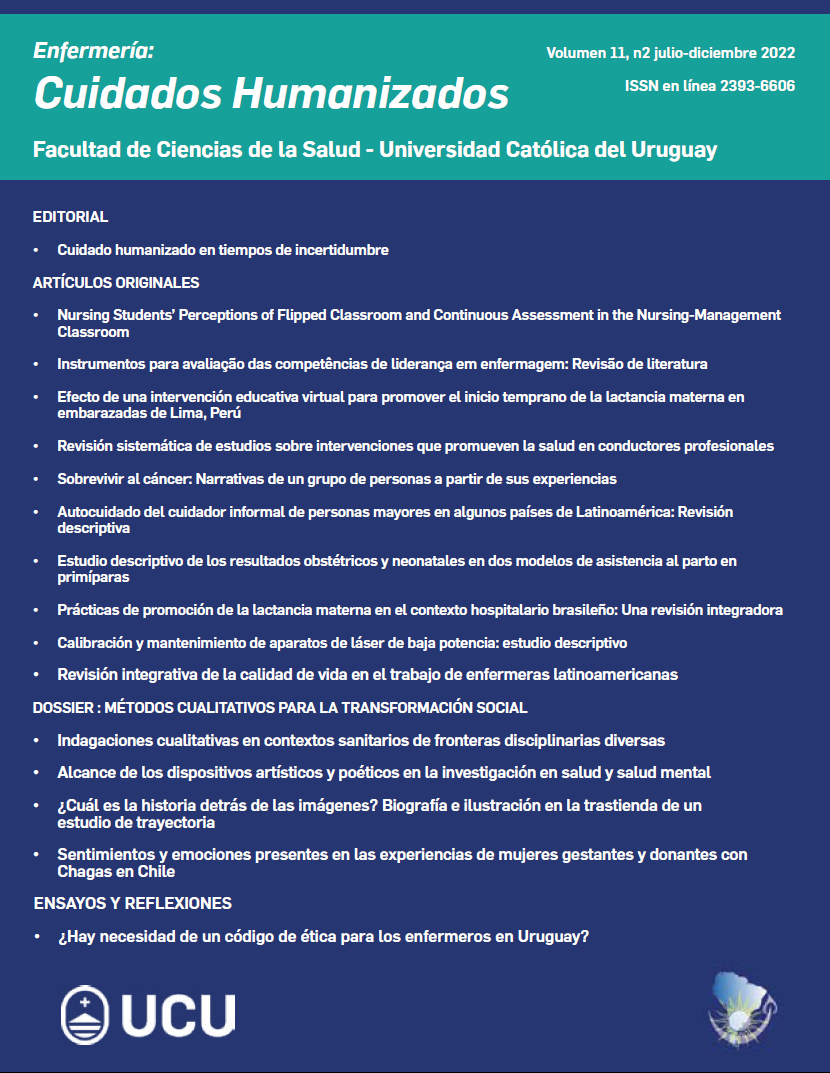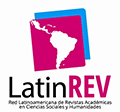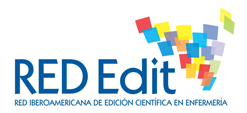Percepções dos alunos de Enfermagem sobre flipped classroom e avaliação contínua na sala de aula de Gestão de Enfermagem
DOI:
https://doi.org/10.22235/ech.v11i2.2833Palavras-chave:
educação em Enfermagem, avaliação educacional, sala de aula invertida, organização e administração, satisfação pessoalResumo
Introdução: Embora a educação de Enfermagem em Administração e Gestão tenha um grande impacto no presente e futuro da profissão, os métodos de ensino continuam a ser tradicionais em muitos casos. A sala de aula invertida é um método amplamente utilizado na educação em Enfermagem, mas os estudos sobre a sua aplicação à Administração e Gestão de Enfermagem são limitados. Método: Estudo qualitativo utilizando um questionário anônimo (perguntas dicotômicas e abertas). Resultados: 92% dos estudantes ficaram satisfeitos com a metodologia de ensino e 92,9% com a avaliação. Apenas 31,5% já o tinha utilizado antes, mas 83% gostariam de utilizá-lo em mais assuntos. Os estudantes mostraram que a metodologia utilizada havia melhorado a sua opinião sobre o conteúdo e aumentado a sua percepção útil do conteúdo. Conclusão: Os estudantes participantes mostraram-se satisfeitos com o método invertido e com a avaliação contínua. Estas estratégias de ensino podem ajudar a motivar os estudantes de Enfermagem para a disciplina de Administração e Gestão de Enfermagem, o que pode encorajá-los a empreender uma educação de pós-graduação e prática profissional nesta área.Downloads
Referências
Pavlidis G, Downs C, Kalinowski TB, Swiatek‐Barylska I, Lazuras L, Ypsilanti A, Tsatali M. A survey on the training needs of caregivers in five European countries. Journal of Nursing Management. 2020;28(2):385-98. DOI: 10.1111/jonm.12940
De Lange W, Kars MC, Poslawsky IE, Schuurmans MJ, Hafsteinsdóttir TB. Postdoctoral nurses’ experiences with leadership and career development: a qualitative study. Journal of Nursing Scholarship. 2019;51(6):689-98. DOI: 10.1111/JNU.12519
Simas TA, Cain JM, Milner RJ, Meacham ME, Bannon AL, Levin LL, Amir N, Leung K, Ockene JK, Thorndyke LE. A systematic review of development programs designed to address leadership in academic health center faculty. Journal of Continuing Education in the Health Professions. 2019;39(1):42-8. DOI: 10.1097/CEH.0000000000000229
Kalaian SA, Kasim RM. Effectiveness of various innovative learning methods in health science classrooms: a meta-analysis. Advances in Health Sciences Education. 2017;22(5):1151-67. DOI: 10.1007/s10459-017-9753-6
Barbour C, Schuessler JB. A preliminary framework to guide implementation of The Flipped Classroom Method in nursing education. Nurse Education in Practice. 2019;34:36-42. DOI: 10.1016/J.NEPR.2018.11.001
Imbernón F, Medina JL. Participative Methodology in the university classroom. Student’s participation. 1st. ed. Science Education Institute, University of Barcelona: Octaedro; 2008.
García-Carpintero E. El portafolio como metodología de enseñanza-aprendizaje y evaluación en el practicum: percepciones de los estudiantes. REDU. Revista de Docencia Universitaria. 2017;15(1):241-57.
Fernández-Martínez E, Gómez del Pulgar M, Rivero Martínez M, Pedraza Anguera AM, Onieva Zafra MD, Beneit Montesinos JV. Una rúbrica evaluadora de competencias investigadoras en residentes de enfermería obstétrico-ginecológica: desarrollo y validación de contenido. NURE Inv. 2018,15(94):1-10.
González-Sanz JD, Barquero-González A, Feria-Lorenzo DJ, León-López R, Martín-Almenta R. Aprender comunicando: una práctica docente innovadora en comunicación científica. Teoría de la Educación. Educación y Cultura en la Sociedad de la Información. 2012;13(3):162-175. DOI: 10.14201/eks.9136
Rodger D, Stewart-Lord A. Students’ perceptions of debating as a learning strategy: A qualitative study. Nurse Education in Practice. 2020;42:102681. DOI: 10.1016/j.nepr. 2019.102681
Ibáñez Masero O, González-Sanz JD. El Blog como herramienta promotora de un aprendizaje enfermero más significativo. Index de Enfermería. 2012;21(1-2):74-76. DOI: 10.4321/S1132-12962012000100016
Cockett A, Jackson C. The use of assessment rubrics to enhance feedback in higher education: An integrative literature review. Nurse Education Today. 2018;69:8-13. DOI: 10.1016/J.NEDT. 2018.06.022
Williams R. Student nurses’ perceptions of the importance of their Practice Assessment Record (PAR): A qualitative study. Nurse Education Today. 2018;71:220-5. DOI: 10.1016/j.nedt. 2018.09.023
Ten Hoeve Y, Castelein S, Jansen G, Roodbol P. Dreams and disappointments regarding nursing: Student nurses’ reasons for attrition and retention. A qualitative study design. Nurse Education Today. 2017;54:28-36. DOI: 10.1016/J.NEDT.2017.04.013
Im S, Jang SJ. Effects of a clinical practicum using flipped Learning among undergraduate nursing students. Journal of Nursing education. 2019;58(6):354-6. DOI: 10.3928/01484834-20190521-06
Scammell JM, Apostolo JL, Bianchi M, Costa RD, Jack K, Luiking ML, Nilsson S. Learning to lead: A scoping review of undergraduate nurse education. Journal of Nursing Management. 2020;28(3):756-65. DOI: 10.1111/JONM.12951
Francl TJ. Is flipped learning appropriate. Journal of Research in Innovative Teaching. 2014;71:119-128.
Oh J, Kim SJ, Kim S, Vasuki R. Evaluation of the effects of flipped learning of a nursing informatics course. Journal of Nursing Education. 2017;56(8):477-83. DOI: 10.3928/01484834-20170712-06
Boruff R. Nursing Students Choose Their Own Role in a Flipped Classroom Approach. Innovative Learning Activities. Journal of Nursing Education. 2018;57(7):450. DOI: 10.3928/01484834-20180618-13
Bingen HM, Steindal SA, Krumsvik R, Tveit B. Nursing students studying physiology within a flipped classroom, self-regulation and off-campus activities. Nurse Education in Practice. 2019;35:55-62. DOI: 10.1016/J.NEPR.2019.01.004
Gubrium JF, Holstein JA, Marvasti AB, McKinney KD. The Sage handbook of interview research: The complexity of the craft. 2nd ed. Sage Publications; 2012.
El-Banna MM, Whitlow M, McNelis AM. Flipping around the classroom: accelerated Bachelor of Science in Nursing students' satisfaction and achievement. Nurse Education Today. 2017;56:41-6. DOI: 10.1016/J.NEDT.2017.06.003
Graneheim UH, Lundman B. Qualitative content analysis in nursing research: concepts, procedures and measures to achieve trustworthiness. Nurse Education Today. 2004;24(2):105-12. DOI:10.1016 / j.nedt.2003.10.001
Rozas MR, Costa J. Autoevaluación del aprendizaje en enfermería con ejercicios interactivos del pograma Hot Potatoes. Educación Médica. 2008;11(1):19-27.
Lewis, P., Hunt, L., Ramjan, L.M., Daly, M., O’Reilly, R., & Salamonson, Y. Factors contributing to undergraduate nursing students' satisfaction with a video assessment of clinical skills. Nurse Educ Today. 2020;84:104-244. DOI: 10.1016/j.nedt.2019.104244
Lavoie‐Tremblay M, Sanzone L, Aubé T, Bigras C, Cyr G, Primeau G. A university/healthcare in4titution mentorship programme: Improving transition to practice for students. Journal of Nursing Management. 2020;28(3):586-94. DOI: 10.1111/jonm.12960
Betihavas V, Bridgman H, Kornhaber R, Cross M. The evidence for ‘flipping out’: a systematic review of the flipped classroom in nursing education. Nurse Education Today. 2016;38:15-21. DOI: 10.1016/J.NEDT.2015.12.010
Huang HL, Chou CP, Leu S, You HL, Tiao MM, Chen CH. Effects of a quasi-experimental study of using flipped classroom approach to teach evidence-based medicine to medical technology students. BMC Medical Education. 2020;20(1):1-9. DOI: 10.1186/s12909-020-1946-7
Oliver R, Luther L. Flipping the graduate nursing classroom: an integrative review. Journal of Nursing Education. 2020;59(6):305-10. DOI: 10.3928/01484834-20200520-02.
Green RD, Schlairet MC. Moving toward heutagogical learning: Illuminating undergraduate nursing students' experiences in a flipped classroom. Nurse Education Today. 2017;49:122-8. DOI: 10.1016/j.nedt.2016.11.016
Finnegan AP, Di Lemma L, Moorhouse I, Lambe RE, Soutter EM, Templeman J, Ridgway V, Hynes C, Simpson R, McGhee S. Educating nurses to deliver optimum care to military veterans and their families. Nurse Education in Practice. 2020;42:102654. DOI: 10.1016/J.NEPR.2019.102654
Das A, Lam TK, Thomas S, Richardson J, Kam BH, Lau KH, Nkhoma MZ. Flipped classroom pedagogy: Using pre-class videos in an undergraduate business information systems management course. Education + Training. 2019;61(6):756-774. DOI: 10.1108/ET-06-2018-0133
Joyce BL, Harmon MJ, Johnson RG, Hicks V, Brown‐Schott N, Pilling LB. Using a quality improvement model to enhance community/public health nursing education. Public Health Nursing. 2019;36(6):847-55. DOI: 10.1111/phn.12656
Fernández-Ponce C, Arbulo-Echevarría M, Muñoz-Miranda JP, Aguado E, García-Cózar F. Análisis de la evaluación continua en el contexto del EEES. Revista Docencia e Investigación. 2017;1(27):81-100.
Craft JA, Christensen M, Shaw N, Bakon S. Nursing students collaborating to develop multiple-choice exam revision questions: A student engagement study. Nurse Education Today. 2017;59:6-11. DOI: 10.1016/j.nedt.2017.08.009
Liu YQ, Li YF, Lei MJ, Liu PX, Theobald J, Meng LN, Liu TT, Zhang CM, Jin CD. Effectiveness of the flipped classroom on the development of self-directed learning in nursing education: a meta-analysis. Frontiers of Nursing. 2018;5(4):317-29.
Downloads
Publicado
Como Citar
Edição
Secção
Licença
Direitos de Autor (c) 2022 Enfermería: Cuidados Humanizados

Este trabalho encontra-se publicado com a Licença Internacional Creative Commons Atribuição 4.0.

















